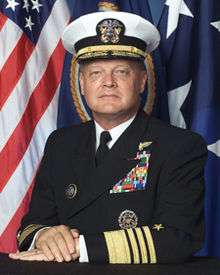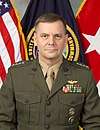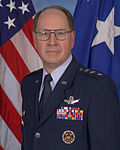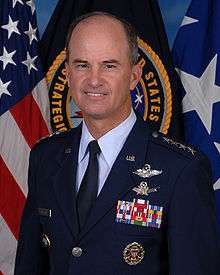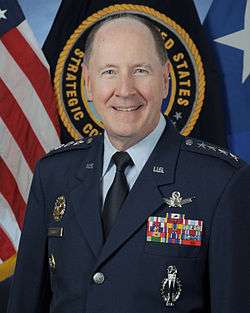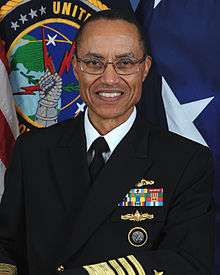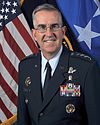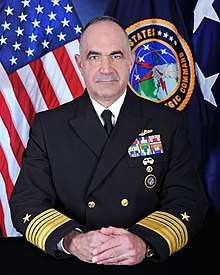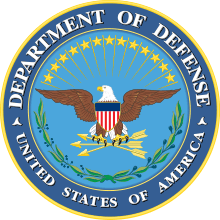United States Strategic Command
United States Strategic Command (USSTRATCOM) is one of the eleven unified combatant commands in the United States Department of Defense. Headquartered at Offutt Air Force Base, Nebraska, USSTRATCOM is responsible for strategic deterrence, global strike, and operating the Defense Department's Global Information Grid. It also provides a host of capabilities to support the other combatant commands, including integrated missile defense; and global command, control, communications, computers, intelligence, surveillance, and reconnaissance (C4ISR). This command exists to give national leadership a unified resource for greater understanding of specific threats around the world and the means to respond to those threats rapidly.[1][2]
| United States Strategic Command | |
|---|---|
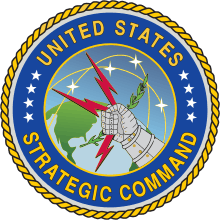 The official seal of the United States Strategic Command. | |
| Active | 1 June 1992 to present |
| Country | |
| Type | Functional Combatant Command |
| Role | Strategic deterrence, global strike, integrated missile defense, global C4ISR |
| Part of | |
| Headquarters | Offutt Air Force Base, Nebraska, U.S. |
| Nickname(s) | STRATCOM, USSTRATCOM |
| Motto(s) | Peace is our Profession |
| Commanders | |
| Current commander | Admiral Charles A. Richard, USN |
| Senior enlisted leader | CCM Patrick F. McMahon, USAF |
Mission statement
USSTRATCOM employs nuclear, cyber, global strike, joint electronic warfare, missile defense, and intelligence capabilities to deter aggression, decisively and accurately respond if deterrence fails, assure allies, shape adversary behavior, defeat terror, and define the force of the future.[3]
Priorities
- Strategic Deterrence
- Decisive Response
- A Combat-Ready Force[3]
Commander's intent
- Embrace strategic deterrence, consisting of innovative joint fighting forces integrated and synchronized in multiple domains to ensure national security.
- Ensure a decisive response to aggression, against any threat, when called upon by civilian national leadership.
- Anticipate and meet tactical, theater, and strategic demands through operational plans and capability development.
- Develop the next generation of people and capabilities in order to prevail in future conflicts.[3]
Headquarters organizational structure
- J1 – Manpower & Personnel: Develops and administers command manpower and personnel policies, human resources, and personnel assignment programs.[3]
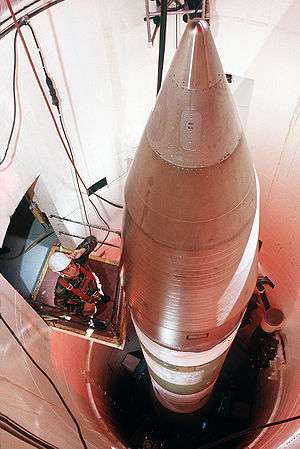
- J2 – Intelligence: Responsible for delivering all-source intelligence while enabling the execution of assigned strategic deterrence, space and cyberspace operations. Directs all intelligence-related support for the commander and ensures unity of intelligence effort across the Command.[3]
- J3 – Global Operations: Coordinates the planning, employment and operation of DoD strategic assets and combines all current operations, intelligence, and global command and control operations. Subdivisions within J3 include Combat and Information Operations, Current Operations, Logistics, and Joint Electromagnetic Spectrum Operations (JEMSO).[3]
_transits_the_Atlantic_Intracoastal_Waterway_as_it_returns_to_Naval_Submarine_Base_Kings_Bay%2C_Ga._from_a_patrol_mission.jpg)
- J4 – Logistics: The Logistics Directorate plans, coordinates and executes joint logistics functions, and provides capability-based readiness assessments and facilities management in support of U.S. Strategic Command's global mission.[3]
- J5 – Plans and Policy: Responsible for coordinating the development and implementation of national security policy as it applies to the command and the execution of its mission. Develops future plans, policy and strategy across all mission areas as outlined in the Unified Command Plan.[3]
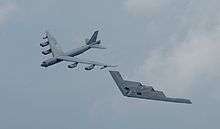
- J6 – C4 Systems: Coordinates, facilitates, monitors and assesses systems, networks and communications requirements.[3]
- J7 – Joint Exercises, Training and Assessments: Manages the USSTRATCOM commander's Joint Exercises, Training, and Assessments programs in order to ensure readiness to perform the Command missions. Provides modeling and simulation support for exercises and training events to the Joint Chiefs of Staff (JCS), Combatant Commands, and other Major Commands (MAJCOM). Manages the Joint Lessons Learned Program. Augments the battle staff during a crisis.[3]
- J8 – Capability and Resource Integration: Conducts force management and analysis to include integrating, coordinating, prioritizing, and advocating USSTRATCOM future concepts, mission capability needs, weapons system development, support for emerging technologies, and command and control architecture across the mission areas. Responsible for all command requirement processes, and ensures appropriate decision support tools and assessment processes are in place to enhance operational capabilities.[3]
- J10 – Joint Reserve Directorate: The Joint Reserve Directorate advises CDRUSSTRATCOM and staff on matters related to the Army, Air Force, Navy, and Marine Corps Reserve personnel assigned to USSTRATCOM. The J10 coordinates Reserve funding requests with the applicable service.[3]
Component structure
U.S. Strategic Command's day-to-day planning and execution for the primary mission areas is performed by the following USSTRATCOM components:
- Joint Force Air Component Commander (JFACC), Barksdale AFB, LA – Conducts kinetic (nuclear and conventional) and non-kinetic effects planning and execution. JFACC manages global force air activities to assure allies and to deter and dissuade actions detrimental to the United States and its global interests; should deterrence fail, employs global strike air forces (bombers and ICBMs) in support of combatant commander.[3]
- Joint Forces Maritime Component Commander (STRATCOM) (JFMCC), Naval Station Norfolk, Norfolk, VA – to conduct operations in the maritime environment for strategic deterrence. It is commanded by US Fleet Forces Command.[3][4]
- JFCC – Integrated Missile Defense (JFCC-IMD) Schriever AFB, CO – JFCC-IMD is constantly monitoring for any missile activity or threat against the United States and its allies. In the event of an attack, IMD plans and coordinates the necessary actions to counter the threat. When directed, also provides alternate missile defense execution support.[3]
- Joint Warfare Analysis Center (JWAC) Dahlgren, VA – The Joint Warfare Analysis Center (JWAC) provides combatant commands, Joint Staff, and other customers with precise technical solutions in order to carry out the national security and military strategies of the United States. JWAC maintains and enhances its ability to conduct comprehensive technical analysis.[5]
Service components
Army
- Army Space and Missile Defense Command/Army Forces Strategic Command (SMDC/ARSTRAT)
Marines
- Marine Corps Forces Strategic Command (MARFORSTRAT) Helps to coordinate USMC and StratCom in areas such as "space, cyberspace, electronic warfare, and combating weapons of mass destruction".[6]
Navy
- Fleet Forces Command (USFF)[7]
Air Force
- Air Force Global Strike Command (AFGSC)
Command posts
The Global Operations Center, or GOC, is the nerve center for USSTRATCOM. The GOC is responsible for the global situational awareness of the commander, USSTRATCOM, and is the mechanism by which he exercises operational command and control of the Nation's global strategic forces.[1]
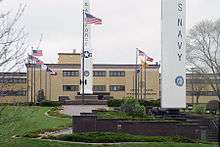
The Alternate Processing and Correlation Center in the USSTRATCOM Underground Command Complex at Offutt AFB provides an alternate missile warning correlation center to the Cheyenne Mountain Missile Warning Center. It is the prime source of missile warning data for USSTRATCOM for force survival and force management. The facility consists of the integration of the SCIS, CSSR, and CCPDS-R systems and also upgrade equipment and communications links.[8]
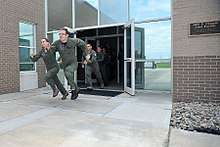
U.S. Strategic Command's Airborne Command Post (ABNCP), also called "Looking Glass", allows USSTRATCOM the ability to command, control, and communicate with its nuclear forces should ground-based command centers become inoperable.[9]
History
USSTRATCOM was originally formed in 1992, as a successor to Strategic Air Command[10] in response to the end of the Cold War and a new vision of nuclear warfare in U.S. defense policy.[11][12] Department of Defense changes in command structure due to the "Goldwater-Nichols Act" of 1986, led to a single command responsible for all strategic nuclear weapons. As a result, USSTRATCOM's principal mission was to deter military attack, and if deterrence failed, to counter with nuclear weapons.[13]
Throughout its history, it has drawn from important contributions from many different organizations stretching back to World War II. Providing national leadership with a single command responsible for all strategic nuclear forces, General George Butler, in establishing the new command, borrowed from the work of General Curtis LeMay, an early commander of Strategic Air Command. LeMay was a very vocal advocate for a strong national defense, particularly as regards nuclear weapons.[12]
Being a Unified Command, another major concern for Gen. Butler was interservice rivalry, having soldiers, sailors, airmen and marines in one command.[12] There had been decades of rivalry between the branches of the U.S. military regarding control of nuclear weapons. Even though a compromise had established the Joint Strategic Target Planning Staff, there were systemic and institutional problems that could not be overcome.
USSTRATCOM was re-structured 1 October 2002 by Secretary of Defense Donald Rumsfeld.[11] It was now to merge with the United States Space Command and assume all duties for full-spectrum global strike, operational space support, integrated missile defense, and global Command, Control, Communications, Computers, Intelligence, Surveillance and Reconnaissance (C4ISR) and specialized planning.[10] Its duties now include intelligence and cyber support as well as monitoring orbiting satellites and space debris.
In February 2008, USSTRATCOM succeeded in destroying a satellite, USA193, about to re-enter the earth's atmosphere.[14]
USSTRATCOM also supported United States Africa Command's 2011 military intervention in Libya in a variety of ways, including long-range conventional strikes and intelligence, surveillance and reconnaissance (ISR).[15]
An intention by the U.S. Air Force to create a 'cyber command' was announced in October 2006.[16] On 21 May 2010, part of USSTRATCOM's responsibility regarding cyber-warfare operations was spun off into a 10th Unified Command, the United States Cyber Command. As a result, USSTRATCOM's Joint Task Force-Global Network Operations (JTF-GNO) and Joint Functional Component Command – Network Warfare (JFCC-NW) were disestablished.
List of combatant commanders
| No. | Commander | Term | Service branch | |||
|---|---|---|---|---|---|---|
| Portrait | Name | Took office | Left office | Term length | ||
| 1 | General George L. Butler | 1 June 1992 | 14 February 1994 | 1 year, 258 days |  U.S. Air Force | |
| 2 | Admiral Henry G. Chiles Jr. | 14 February 1994 | 21 February 1996 | 2 years, 7 days |  U.S. Navy | |
| 3 | General Eugene E. Habiger | 21 February 1996 | 1 August 1998 | 2 years, 161 days |  U.S. Air Force | |
| 4 | Admiral Richard W. Mies | 1 August 1998 | 2002 | ~ 3 years, 153 days |  U.S. Navy | |
| 5 | Admiral James O. Ellis Jr. | 2002 | 9 July 2004 | ~ 2 years, 190 days |  U.S. Navy | |
| - | General James E. Cartwright Acting | 9 July 2004 | 1 September 2004 | 54 days | 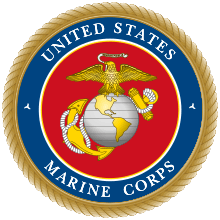 U.S. Marine Corps | |
| 6 | General James E. Cartwright | 1 September 2004 | 10 August 2007 | 2 years, 343 days |  U.S. Marine Corps | |
| - | Lieutenant General C. Robert Kehler Acting | 10 August 2007 | 3 October 2007 | 54 days |  U.S. Air Force | |
| 7 | General Kevin P. Chilton | 3 October 2007 | 28 January 2011 | 3 years, 117 days |  U.S. Air Force | |
| 8 | General C. Robert Kehler | 28 January 2011 | 15 November 2013 | 2 years, 291 days |  U.S. Air Force | |
| 9 | Admiral Cecil D. Haney | 15 November 2013 | 3 November 2016 | 2 years, 354 days |  U.S. Navy | |
| 10 | General John E. Hyten | 3 November 2016 | 18 November 2019 | 3 years, 15 days |  U.S. Air Force | |
| 11 | Admiral Charles A. Richard | 18 November 2019 | Incumbent | 3 years, 285 days |  U.S. Navy | |
See also
- Nuclear weapons and the United States
- Strategic Air Command
References
- "About". www.stratcom.mil.
- "History". www.stratcom.mil.
- "Command Snapshot". www.stratcom.mil.
- "US Fleet Forces Commander Designated as NAVSTRAT, JFMCC STRAT". stratcom.mil. Retrieved 26 March 2019.
- "Joint Warfare Analysis Center". jwac.mil. Retrieved 20 December 2018.
- "MARFORSTRAT – Headquarters". stratcom.mil. Archived from the original on 17 February 2013. Retrieved 6 March 2013.
- "U.S. Strategic Command Service Components". stratcom.mil. Archived from the original on 13 November 2013. Retrieved 13 November 2013.
- "E-6B Airborne Command Post (ABNCP)". stratcom.mil.
- W. Spencer Johnson (2002). "New Challenges for the Unified Command Plan" (PDF). www.dtic.mil. Archived from the original (PDF) on 17 October 2005. Retrieved 30 July 2018.
- "USSTRATCOM Celebrates 15 Years". www.stratcom.mil. USSTRATCOM Public Affairs. 25 September 2017. Retrieved 29 July 2018.
- Rita Clark (LtCol, USAFR); Dr. Vincent Giroux, Jr.; Dr. Todd White (15 August 2013). History of the United States Strategic Command (USSTRATCOM) – Nuclear Weapons, Cold War Strategy, Service Rivalries, Arms Control. Progressive Management. ISBN 978-1-30-101083-7.
- "History". US Strategic Command. January 2018. Retrieved 29 July 2018.
In addition to the dramatic changes in the global landscape associated with the end of the Cold War, changes in the structure of the DoD stemming from the 1986 "Goldwater-Nichols Act" led national leaders to favor a single command responsible for all strategic nuclear forces. The new command's principal mission was to deter military attack, especially nuclear attack, on the United States and its allies and, if deterrence failed, to employ nuclear forces.
- U.S. Strategic Command Public Affairs (1 February 2010). "USSTRATCOM Comments on Space Debris Article". www.stratcom.mil. Retrieved 30 July 2018.
- "History". US Strategic Command. January 2018. Retrieved 29 July 2018.
In 2011, it supported U.S. Africa Command's operations against Libya in a variety of ways, including long-range conventional strikes and ISR.
- John C.K. Daly (9 October 2006). "US Air Force Prepares For Cyber Warfare". Space Daily. Retrieved 30 July 2018.
External links
| Wikimedia Commons has media related to United States Strategic Command. |
- United States Strategic Command Official Website
- US Strategic Command Airborne Command Post Fact Sheet
- Air Force Magazine, Journal of the Air Force Assoc., August 2008.
- FAS: United States Space Command (USSPACECOM)
- GAO Report: Additional Actions Needed by U.S. Strategic Command to Strengthen Implementation of Its Many Missions and New Organization

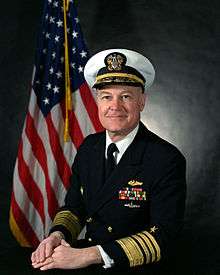
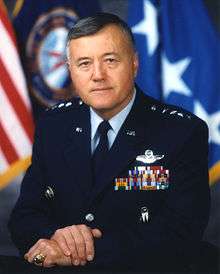
_Richard_W._Mies%2C_USN.jpg)
